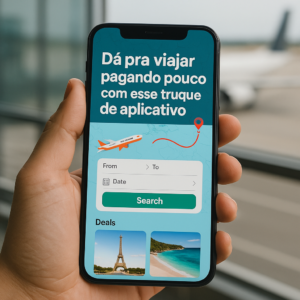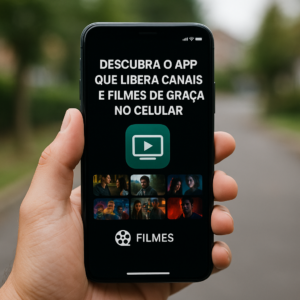Accessibility in Streaming Services: Optimize Your Experience
85% of Facebook videos are watched without sound. This shows the importance of accessibility in streaming services. More than 10 million Brazilians have hearing impairments. And 6.5 million have visual impairments.
THE digital inclusion It is essential for everyone to access audiovisual content. Only 1% of web pages are accessible to people with disabilities. This shows the way forward to improve the accessibility in streaming services.
THE accessibility in streaming services is crucial for the digital inclusion. It is important that everyone, regardless of their needs, has access to quality content. Streaming services should offer features such as subtitles and audio description for a more inclusive experience.
The Importance of Digital Accessibility in Streaming
Digital accessibility is essential to include people with disabilities in streaming. 85% of Facebook videos are watched without sound. This shows how crucial accessibility is in streaming services. Without it, these people would not be able to access audiovisual content.
Additionally, accessibility is important for those who watch videos in noisy places. Or for those who prefer automatic subtitles. The inclusion of features such as audio description and subtitles improve accessibility.
Digital exclusion affects the exercise of citizenship and access to information. It also impacts the education, work and leisure of people with disabilities. digital inclusion improves the personal, professional and social development of these people.
- Automatic subtitles
- Audio description
- Accessibility features
To promote accessibility, it is recommended to use assistive technologies. It is also important to follow digital accessibility standards. It is crucial to involve people with disabilities in the development of technological solutions. In addition, it is essential to carry out regular assessments to identify and remove barriers.
Key Accessibility Features in Streaming Services
To the assistive technologies are essential for streaming accessibility. Netflix, Amazon Prime Video and Disney+ invest in audio description. This is for a wide variety of original and licensed content.
Some of the accessible features include:
- Audio description: Available on series such as Netflix’s “Stranger Things” and “The Crown,” and on many Disney+ films and series.
- Automatic subtitles: Allowing users to adjust the size and color of subtitles.
- Voice Control: Allowing users to control the streaming service with voice commands.
Organizations like Conectar360 work to improve accessibility. They focus on audio description on streaming platforms for people with visual impairments. With over 75% of internet video consumption time in Brazil, it is crucial to invest in assistive technologies.
| Streaming Platform | Accessibility Features |
|---|---|
| Netflix | Audio description, automatic subtitles |
| Amazon Prime Video | Audio description, automatic subtitles |
| Disney+ | Audio description, automatic subtitles |
Subtitles and Closed Captions: Differences and Applications
Automatic subtitles and Closed Captions are essential for streaming accessibility. More than 801,300 viewers who turn on captions do not do so due to a disability. This shows how important these tools are for many users.
There are several types of subtitles, such as open and hidden. Open subtitles are displayed on the video and cannot be removed. Hidden subtitles can be turned on or off by the viewer. In addition, it is possible to customize the subtitles, adjusting the size and color, to improve accessibility.
Available subtitle types
- Open captions: Embedded directly into the video and cannot be disabled
- Closed captions: can be turned on or off by the user
- SDH subtitles (Subtitles for the Deaf and Hard-of-hearing): combine elements of open and closed captions
You Closed Captions They not only transcribe dialogues, but also sound details and who is speaking. This is very helpful for those who are deaf. Automatic subtitles are created by voice recognition software, facilitating accessibility.
Benefits for different audiences
Automatic subtitles and Closed Captions They help a variety of people. This includes those who are hearing impaired, those who prefer to watch videos with subtitles, and those who want to better understand the content. They are also useful in public places, such as airports, where accessibility is crucial.
| Caption type | Features | Benefits |
|---|---|---|
| Open subtitles | Embedded directly into the video | Accessibility in public spaces |
| Closed captions | They can be activated or deactivated | User control and flexibility |
| SDH Subtitles | Combine elements of open and closed captions | Accessibility for people with disabilities |
Audio Description: Making Visual Content Accessible
THE audio description is essential for people with visual impairments to be able to access streaming services. Since 2014, the law has required audio description in government-funded productions. The Brazilian Law for the Inclusion of Persons with Disabilities also promotes equal opportunities, including access to culture on streaming platforms.
Examples of services they offer audio description include Netflix. It has titles with audio description in several languages, such as Portuguese. Some examples are:
- Documentary about singer Anitta
- Movie “Double Father”
- “Stranger Things” series
- Movie “Xico, The Magic Dog”
Other services, such as Amazon Prime Video and Disney+, also have titles with audio description. Demand for audio description has increased, highlighting the importance of including accessible content in multiple formats.
In Brazil, around 6.5 million people have visual impairment. This represents 3.2% of the population. audio description is crucial to ensuring accessibility and inclusion in streaming services.
| Streaming Service | Examples of Titles with Audio Description |
|---|---|
| Netflix | Documentary about singer Anitta, film “Pai em Dobro”, series “Stranger Things” |
| Amazon Prime Video | Films: “The Cave”, “Carlinhos and Carlão”, “Blind Game”, “In Paulinho’s Throat”. Series: “Families Face to Face Brazil”, “Loose in Floripa”, “All or Nothing: Brazilian Team” |
| Disney+ | Movies: “Frozen 2”, “Star Wars Episode VIII: The Last Jedi”, “Star Wars Rogue One”, “Toy Story 4”, “Avengers: Endgame” |
Navigation and Adaptive Interface
Adaptive navigation and interface are essential for accessibility in streaming services. The inclusion of accessible features, such as screen reading and font adjustments, can increase sales by 24%. This was observed at Starbucks.
Screen reader compatibility is crucial for accessibility. Assistive technologies allow users with visual or motor impairments to interact with the service effectively.

Voice control, contrast and size adjustments, and compatibility with screen readers are examples of accessible features. They can be implemented in streaming services. In addition, assistive technologies ensure that the service is accessible to everyone, regardless of needs or disabilities.
Accessibility goes beyond meeting legal requirements. It’s a chance to expand your user base and improve the experience. With accessible features and assistive technologies, streaming services become more inclusive and appealing to many users.
Streaming-Compatible Assistive Technologies
Assistive technologies are essential to ensuring accessibility in streaming services. They allow people with disabilities to access and enjoy streaming content independently.
Screen readers, speech recognition software, and screen magnification devices are common examples. These tools help not only people with disabilities, but also those who watch videos in noisy environments or prefer verbal descriptions.
It is crucial to understand that these technologies are mandatory in many cases. Businesses and schools with people with disabilities must provide these tools for accessibility.
Additionally, these technologies can be adjusted to suit individual needs. For example, virtual assistants like Alexa and Siri can be configured to control the environment by voice. This helps people with motor limitations.
In conclusion, assistive technologies are essential for accessibility in streaming. They benefit people with disabilities and also those who prefer to watch videos with verbal description or in noisy places.
Configuring Your Streaming Service for Maximum Accessibility
To include people with disabilities, it is essential to make the streaming service more accessible.
Recommended Settings
For different needs, it is important to be able to change the size and color of the subtitles. This is very helpful for those who have difficulty seeing.
- Customizable subtitles
- Control volume and video playback with voice commands
- Screen reader compatibility
Assistive technologies, such as audio description, are also very useful. They help those who cannot see the video.
With these adjustments and technologies, it is possible to make the streaming service very accessible. This way, more people with disabilities can enjoy it.
| Resource | Description |
|---|---|
| Subtitles | Text accompanying the video audio |
| Audio description | Description of what is happening in the video |
Streaming Platforms and their Accessibility Features
Streaming platforms have accessibility features different. This helps people with disabilities access content. In Brazil, 15.5 million people face difficulties due to lack of accessibility.
Platforms like Globoplay, Netflix and Amazon Prime Video have varied features. Globoplay has 20 million subscribers, but its descriptive subtitles are inconsistent. Netflix, with 17 million subscribers, offers subtitles and audio descriptions in several languages, but needs to improve its advertising.
Comparison between Services
- Globoplay: 20 million subscribers, inconsistent and insufficient descriptive subtitles
- Netflix: 17 million subscribers, descriptive subtitles and audio description in multiple languages
- Amazon Prime Video: 10 million subscribers, limited availability of descriptive subtitles
Streaming accessibility is always improving. assistive technologies and accessible features are being improved. The legislation is also being implemented to make services more inclusive.
| Platform | Accessibility Features | Number of Subscribers |
|---|---|---|
| Globoplay | Inconsistent and insufficient descriptive captions | 20 million |
| Netflix | Descriptive subtitles and audio description in multiple languages | 17 million |
| Amazon Prime Video | Limited availability of descriptive captions | 10 million |
Digital Accessibility Legislation and Guidelines
THE legislation and the digital accessibility guidelines are essential to ensure accessibility in streaming services. The Brazilian Inclusion Law requires that streaming services be accessible to people with disabilities. Guidelines, such as the Web Content Accessibility Guidelines (WCAG), help ensure this accessibility.
Some important laws in Brazil include:
- Law No. 13,146, of July 6, 2015, which institutes the Brazilian Law for the Inclusion of Persons with Disabilities (Statute of Persons with Disabilities)
- Law No. 12,527, of November 18, 2011, which regulates access to information with references to digital accessibility rights
- Law No. 10,436, of April 24, 2002, which establishes Brazilian Sign Language (Libras)
Digital accessibility is a fundamental right. Streaming companies must follow the digital accessibility guidelines to include all users. The legislation Brazilian law is clear about the responsibilities of companies in this regard.
| Law/Decree | Description |
|---|---|
| Law No. 13,146 | Establishes the Brazilian Law for the Inclusion of Persons with Disabilities |
| Law No. 12,527 | Regulates access to information with references to digital accessibility rights |
| Law No. 10,436 | Establishes Brazilian Sign Language (Libras) |
Future Trends in Streaming Accessibility
To the future trends in streaming accessibility will bring technological innovations amazing. We'll be able to control volume and video with just our voice. There will also be improvements to audio description and compatibility with screen readers.
To the future trends also include subtitle adjustments. You can change the size and color so everyone can see it better. This is essential, as many spend US$$ 46 per month on streaming. Its popularity has grown a lot in recent years, thanks to technology and accessibility.
To the technological innovations are crucial for a good viewing experience. We'll have lower latency, higher-quality video, and features like subtitles and audio description.
Technological innovations
- Control volume and video playback with voice commands
- Improved audio description and screen reader compatibility
- Adjusting the size and color of subtitles
Expected developments
Expected developments include artificial intelligence and machine learning. These can personalize the user experience by up to 60%. Additionally, the adoption of CDNs can increase content delivery by up to 30%.
| Technology | Benefit |
|---|---|
| Artificial intelligence | Increased personalization of user experience |
| CDNs | Increased content delivery rate |
Conclusion
Accessibility in streaming services is essential to include people with disabilities. With features like subtitles, audio descriptions, and adaptive navigation, these services become more equitable. This improves the lives of millions of users.
In Brazil, the law requires that these resources be offered. And there are already leading platforms that are meeting this need with new solutions.
As technology advances, accessibility in streaming will become even more important. We’ll see features like real-time sign language interpreting and improved speech recognition. There will also be ongoing improvements to subtitles and audio description.
With business commitment and public awareness, we can create a better future. A future where accessibility is the rule, not the exception.













